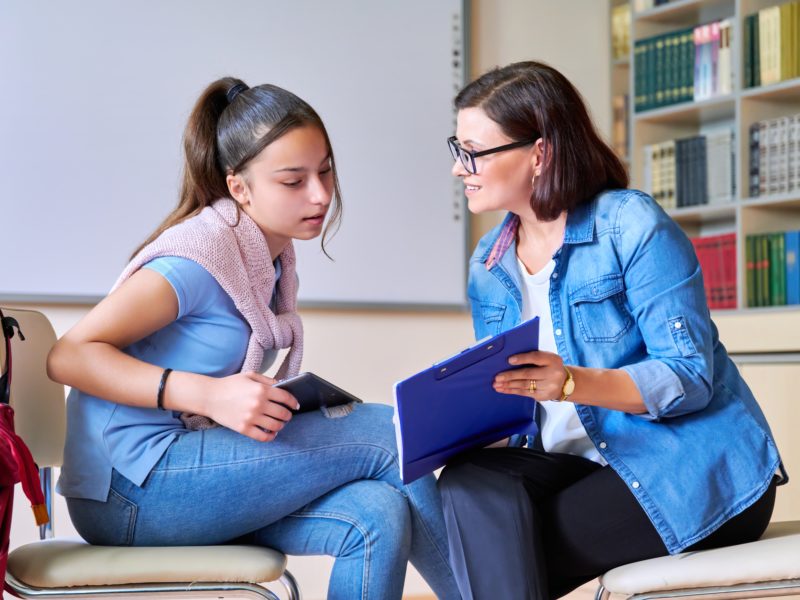Cerebrate Blog.
Explore strategies for skill development

9 Ways to Model Self-Monitor
Posted In Teaching On April 6, 2023
Self-monitoring is a vital executive function skill that enables individuals to evaluate their own performance and behavior within a given situation. To help students develop this crucial ability, educators can model self-monitor in everyday classroom interactions. Modeling self-monitor not only guides students in building self-awareness but also equips them with the tools they need for academic success and positive social interactions. For students who struggle with self-monitor, observing these strategies in action can make a transformative difference.
Here are nine effective ways to model self-monitor for your students:
-
Think Aloud While Reviewing Work
When creating or completing something in front of your class, verbalize your thought process as you review your work for accuracy. For example, while solving a math problem, explain how you double-check your steps to ensure the solution is correct. This simple practice helps students understand how to evaluate their own work and make adjustments.
-
Reflect on Lessons with Your Students
After finishing a lesson, model self-monitor by discussing what worked well and identifying areas for improvement. Share how you evaluate your performance and encourage students to reflect on their own learning experiences. This not only demonstrates self-monitoring but also fosters a growth mindset in your students.
-
Use Checklists for Quality Assurance
Show your students how you use a checklist to review and revise your emails or other written communications before sending them. Highlight how this practice helps you catch mistakes and improve clarity. By modeling self-monitor in this context, you teach students the value of thoroughness and attention to detail.
-
Reframe Negative Thoughts
When you experience a negative thought, share it with your students and explain how you reframe it into a more positive or constructive perspective. For instance, if you feel frustrated about a challenging situation, discuss how you shift your focus to problem-solving. Modeling self-monitor in this way demonstrates emotional regulation and resilience.
-
Discuss Emotional Awareness
Talk openly about a feeling you are experiencing and explain how you consider what situations might cause others to feel the same way. This helps students develop empathy and understand the connection between emotions and actions. When you model self-monitor by articulating these processes, you provide a roadmap for students to follow.
-
Demonstrate Skill Development
Share the steps you are taking to improve a skill you want to develop. For example, if you are learning a new teaching method or hobby, walk your students through how you set goals, track progress, and adjust your approach as needed. This transparent process models self-monitor while encouraging students to view skill-building as an ongoing journey.
-
Model Active Listening
During conversations with students, demonstrate active listening by maintaining eye contact, nodding, and summarizing what they say. Explain why these actions are important for understanding and building strong communication skills. Modeling self-monitor through active listening shows students how to remain present and engaged.
-
Ask Questions to Understand Different Perspectives
When you encounter a disagreement, share the questions you ask yourself to better understand the other person’s point of view. For example, you might say, “Why do they see it this way? What experiences might have shaped their perspective?” This approach not only models self-monitor but also teaches students how to approach conflicts constructively.
-
Stay Focused and Inquisitive
During class discussions, model self-monitor by showing how you stay focused and ask meaningful questions about the topic being covered. Explain how this practice deepens your understanding and keeps you engaged. Encourage students to adopt similar habits when participating in discussions.
Why Modeling Matters
Students often learn best by observing and imitating the behaviors of trusted adults. When you model self-monitor consistently, you show your students how to evaluate their own actions, identify areas for growth, and make meaningful adjustments. These skills will serve them well both inside and outside the classroom, fostering independence, confidence, and resilience.
Incorporating these strategies into your daily teaching practice creates a supportive environment where students feel empowered to develop their self-monitoring abilities. By modeling self-monitor in diverse contexts, you provide students with tangible examples they can emulate. With time and practice, they’ll begin to see themselves not just as learners but as capable, reflective individuals ready to take on challenges.
By modeling self-monitor, you’re not just teaching students a skill—you’re equipping them with a mindset that will benefit them for life. Make self-monitoring a natural and visible part of your teaching practice, and watch as your students grow in self-awareness and confidence.
Additional Resources
Looking for more ways to teach self-monitoring skills? Explore our related blog posts:
- What is Self-Monitor?
- Clear Ways to Identify Challenges in Self-Monitoring: A Guide for Teachers Elementary Teachers
- Understanding Self-Monitoring and Its Connection to Executive Function Deficits
Stay connected and informed with more strategies to improve students’ academic performance. Sign up for our newsletter today!

